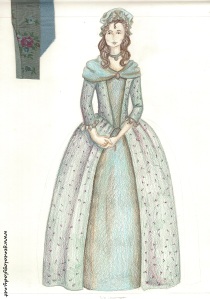 Welcome to my weekly fashion blog post. Each week I will discuss a female garment, fashion trend or influencer from the age of photography (1840s through the 20th century). My goal is to educate family researchers and genealogists about the clothing worn by our ancestors. Dating photographs is an issue we all struggle with as family archivists. Additionally, anyone who writes about their family’s history should be aware of the environment in which their ancestors lived. Period clothing is an important part of that environment from how it affects a person’s movement to their overall lifestyle. This week I introduce you to the Leg o’ Mutton sleeve.
Welcome to my weekly fashion blog post. Each week I will discuss a female garment, fashion trend or influencer from the age of photography (1840s through the 20th century). My goal is to educate family researchers and genealogists about the clothing worn by our ancestors. Dating photographs is an issue we all struggle with as family archivists. Additionally, anyone who writes about their family’s history should be aware of the environment in which their ancestors lived. Period clothing is an important part of that environment from how it affects a person’s movement to their overall lifestyle. This week I introduce you to the Leg o’ Mutton sleeve.
Sleeves from the 1820s-1830s
The Leg o’ Mutton sleeve made its first appearance in the late 1820s; the style continued into the 1830s. The French originally named this style the gigot sleeve due to the sleeve’s unique shape. In French, gigot literally means the hind quarters of an animal. In the English speaking world, the name translated into Leg of Mutton, or Leg o’ Mutton. This sleeve was characterized by voluminous amounts of fabric at the sleeve cap which eventually tapered down narrowly at the wrist. Horsehair and other means of support were required to maintain the “puff.” To balance the ensemble, skirts became wider at the bottom and the waist became deceptively narrower.

American, Cotton dress, c.1832-5 (Courtesy of the Brooklyn Costume Museum at the Metropolitan Museum of Art)
“Oh I am grateful,” protested Anne. “But I’d be ever so much gratefuller if–if you’d made just one of them with puffed sleeves. Puffed sleeves are so fashionable now. It would give me such a thrill, Marilla, just to wear a dress with puffed sleeves.”
– Anne of Green Gables, Lucy M. Montgomery
Fashion Reboot – 1890s
As the bustle made its final decline at the end of the 1880s, a void was created. What would the next fashion trend be? As is typical with fashion, old became new again. The 1890s saw a resurgence (or recycling!) of the Leg o’ Mutton sleeve. As the bustle began to decrease, fashion shifted from an exaggerated posterior to an extreme expansion of shoulder girth.
A cursory glance through fashion journals shows the absence of the Leg O’ Mutton sleeve in 1891. By 1893, sleeves had begun to inflate. The peak of the sleeve appears to have been the years 1895 and 1896, and by 1897, the style was on the wane. (Please note that throughout the same decade, fashion journals consistently showcased sleeves of moderate girth as well. Do not assume that because a woman’s sleeves are narrower in a photograph that it was not during the years 1893-1897 if other clues indicate this time frame). The following plates are courtesy of the Thomas J. Watson Library, Metropolitan Museum of Art (New York).
Further Reading
The Fashion Historian blogged about the original French Gigot sleeve from the 1830s.
A definition and history of Gigot sleeve from the Fashion Encyclopedia.
Collection of Fashion plates from the Costume Institute of the Metropolitan Museum of Art. Most of the plates are in the public domain.
©2015 Deborah Sweeney
Post originally found: https://genealogylady.net/2015/07/12/fashion-moments-leg-o-mutton-sleeves/









